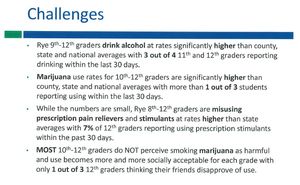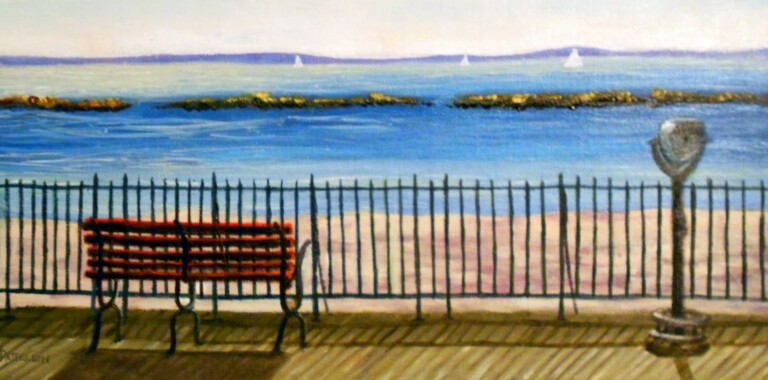Rye ACT, Drugs & Alcohol in Rye and the 5,000 Missing Pieces: Guest Column by Lauren Rosen
By Lauren Rosen, LCSW-R, Individual and Family Therapist
There are just over 5,000 homes in Rye City. And it all starts at home.
As parents, we all know this, but it is often easier to “talk the talk” than it is to “walk the walk”. After attending the Town Hall meeting for the RyeACT Coalition last week, many thoughts went through my head. Overall, I felt inspired that the conversation was beginning to happen. But I also had some serious concerns. The percentages of Rye teenagers who are using alcohol and marijuana are alarmingly high – higher than the rest of Westchester County and New York State, and this is frightening for me.
(PHOTO: Rye City indexes above New York State and National averages for certain risk behaviors, as described in part of Rye ACT's presentation called "Challenges". You can download the entire presentation here.)
Like most of us in today’s world, I wear many hats. I am a Licensed Clinical Social Worker who has been working for 20+ years with adolescents and families. I worked for more than 10 years in the substance abuse and prevention field and this is my third experience working with coalitions as a professional. I am currently in private practice in Rye and I work with teenagers, adults and families dealing with many issues, including but not limited to substance abuse. Some of these people are from Rye. Finally, I am the mother of 3 teenagers, all in the Rye Schools. My worlds are colliding.
RyeACT has done a tremendous job of bringing 12 different sectors of our community together (ie: the schools, clergy, local businesses, law enforcement, mental health professionals, students, to name a few) and it was exciting to hear some of these representatives speak the other night. The new Police Commissioner talked about the role that law enforcement plays and will be playing in the future. Representatives from the Rye Youth Council and the Rye YMCA also spoke about their important roles in the community and it was equally exciting to hear parent suggestions about ways the school can be involved to do their part. Many wonderful ideas are being discussed, yet there is a piece I am worried about that is getting missed, and that is what each and every one of us, as parents, can do. This is the hardest part.
I would love for each parent to join me in just taking a moment and pause. Really look at yourself and ask yourself some critical questions: What are your own personal views on alcohol, marijuana, tobacco, cocaine, pills, etc. What are your own values on using these substances? How much do you use these substances? When do you use these substances? What is your attitude towards these substances? These are not easy questions to answer and there is obviously no “right” or “wrong” answer. But it is worth it to ask yourself these questions and just think about it. Alone. Sit with your thoughts.
When you have had a chance to think about your own thoughts, talk to your spouse or significant other. Privately. Think about your own values and then what messages you send to your kids. Is it the message you want them to get? These are tough questions and certainly made me stop and think as I thought about my own personal views on alcohol and other substances and the messages I want to teach my children.
We teach our kids all of the time, many times not by lecturing but by example. Simple comments such as, “I’ve been looking forward to a cold one all day”, or “ Boy do I need a drink” or “It’s 5:00 somewhere!” are comments that our children and teenagers hear frequently. They notice and pay attention to the subtle message that sends. Just think about that. How often have you heard statements similar to these or thought them or said them out loud? I am always amazed when teenagers, both in my home and in my office, can talk about the adults who are wasted, trashed, drunk and the messages these teens take away from witnessing this behavior. And believe me, they see this behavior.
We are on the brink of summer: proms, graduations, BBQs, beach parties, a lot of unsupervised time for teenagers and a lot of partying for both teenagers and adults. Please join me and take some time to just pause and think about your attitudes towards substances and the messages you portray, both subtlety and not so subtlety. Although it is wonderful to have so many facets of our community involved in helping our young people make good decisions, we have to do our part as parents too. It is great to look externally for helping our young people, but often the most powerful messages come from inside our home. “Talk the talk”, but don’t forget to “walk the walk”.
++++
++++






